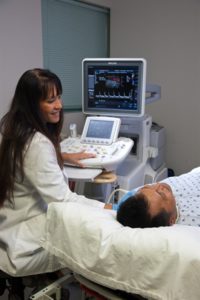 Sonography (Ultrasound)
Sonography (Ultrasound)
Ultrasound is used to produce images of many parts of the body using sound waves that reflect or echo back off internal organs of the body. The high frequency sound waves are passed through the body by a device called a transducer that is pressed gently against the skin. These sound waves are converted into real-time digital images that are interpreted by the radiologist.
Ultrasound does not use any type of radiation in order to produce the digital images, which makes it a safe alternative for imaging during pregnancy.
PATIENT EXPECTATION
All Ultrasound procedures are performed with the patient changing into a procedure gown and laying on a procedure table. The sonographer (person performing the procedure) will place a small amount of gel on the skin to prevent air from getting between the skin and the transducer. The sonographer will then move the transducer over the skin, and you may feel a slight pressure as the transducer is moved. This movement is what is producing the sound waves that generate the digital images.
Obstetrical (OB) ultrasound examinations may involve the use of a transducer that is inserted into the vaginal canal. If this is required, the sonographer will explain the process in advance.
During the examination, it is important to stay as relaxed as possible and follow the sonographer’s instructions. This will assure that the best images possible are obtained for interpretation by the radiologist.
PATIENT PREPARATION
Many ultrasound examinations do not require specific patient preparation prior to having the study performed. There are, however examinations that do require specific preparation guidelines and those will be reviewed with you when the examination is scheduled. The preparations are generally dietary restrictions and may involve the drinking of water prior to the examination.
PROCEDURE SIDE EFFECTS / COMPLICATIONS
There are no side effects or complications associated with having an ultrasound examination.
PROCEDURE FOLLOW-UP CARE
Please follow up with your primary care physician for results.
